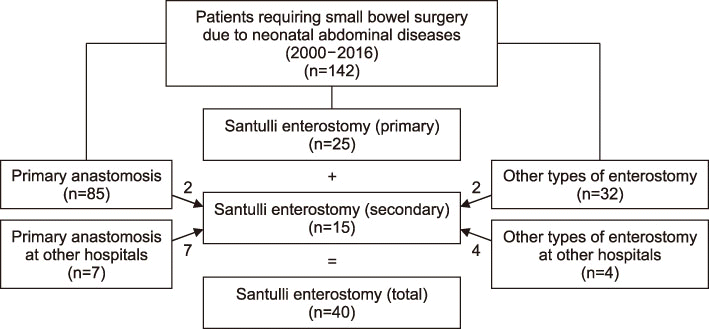1. van Zoonen AG, Schurink M, Bos AF, Heineman E, Hulscher JB. Ostomy creation in neonates with acute abdominal disease: friend or foe? Eur J Pediatr Surg. 2012; 22:295–299.

2. Santulli TV, Blanc WA. Congenital atresia of the intestine: pathogenesis and treatment. Ann Surg. 1961; 154:939–948.
3. Sapin E, Carricaburu E, De Boissieu D, Goutail-Flaud MF, Benammar S, Helardot PG. Conservative intestinal surgery to avoid short-bowel syndrome in multiple intestinal atresias and necrotizing enterocolitis: 6 cases treated by multiple anastomoses and Santulli-type enterostomy. Eur J Pediatr Surg. 1999; 9:24–28.
4. Yeung F, Tam YH, Wong YS, Tsui SY, Wong HY, Pang KK, et al. Early reoperations after primary repair of Jejunoileal atresia in newborns. J Neonatal Surg. 2016; 5:42.

5. Rees CM, Eaton S, Khoo AK, Kiely EM. Members of NET Trial Group. Pierro A. Peritoneal drainage does not stabilize extremely low birth weight infants with perforated bowel: data from the NET Trial. J Pediatr Surg. 2010; 45:324–328. discussion 328–9.
6. Vanamo K, Rintala R, Lindahl H. The Santulli enterostomy in necrotising enterocolitis. Pediatr Surg Int. 2004; 20:692–694.

7. Zani A, Lauriti G, Li Q, Pierro A. The timing of stoma closure in infants with necrotizing enterocolitis: a systematic review and meta-analysis. Eur J Pediatr Surg. 2017; 27:7–11.

8. Ahlgren LS. Apple peel jejunal atresia. J Pediatr Surg. 1987; 22:451–453.

9. Tepetes K, Liakou P, Balogiannis I. The use of the Santulli enterostomy. World J Surg. 2007; 31:1343–1344.
10. Steinau G, Ruhl KM, Hörnchen H, Schumpelick V. Enterostomy complications in infancy and childhood. Langenbecks Arch Surg. 2001; 386:346–349.

11. Lee J, Kang MJ, Kim HS, Shin SH, Kim HY, Kim EK, et al. Enterostomy closure timing for minimizing postoperative complications in premature infants. Pediatr Neonatol. 2014; 55:363–368.

12. Struijs MC, Sloots CE, Hop WC, Tibboel D, Wijnen RM. The timing of ostomy closure in infants with necrotizing enterocolitis: a systematic review. Pediatr Surg Int. 2012; 28:667–672.

13. Waldhausen JH, Sawin RS. Improved long-term outcome for patients with jejunoileal apple peel atresia. J Pediatr Surg. 1997; 32:1307–1309.

14. Wit J, Sellin S, Degenhardt P, Scholz M, Mau H. Is the Bishop-Koop anastomosis in treatment of neonatal ileus still current? Chirurg. 2000; 71:307–310.
15. Gause CD, Hayashi M, Haney C, Rhee D, Karim O, Weir BW, et al. Mucous fistula refeeding decreases parenteral nutrition exposure in postsurgical premature neonates. J Pediatr Surg. 2016; 51:1759–1765.

16. Aguayo P, Fraser JD, Sharp S, St Peter SD, Ostlie DJ. Stomal complications in the newborn with necrotizing enterocolitis. J Surg Res. 2009; 157:275–278.





 PDF
PDF ePub
ePub Citation
Citation Print
Print




 XML Download
XML Download